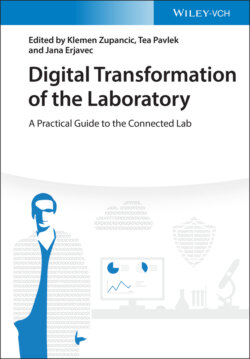Читать книгу Digital Transformation of the Laboratory - Группа авторов - Страница 26
1.2.6.1 New Science in Health Care
ОглавлениеThe biggest drive recently in health care, for both diagnosis and treatment, has been the move away from more population‐based approaches toward a much more personalized focus. This has been made possible by the huge advancements in gene and genome‐based technologies. Advances in gene and whole‐genome sequencing will continue to assist better diagnosis, with sequencing times and costs reducing dramatically, and accuracy and quality rising significantly. These advances will make the protocol‐driven labs more prevalent, more efficient, and more cost‐effective. The development of better treatments based on gene expression manipulation and gene editing (e.g. CRISPR) [4]) as well as pure gene therapy [88] will continue apace. Diseases that will benefit from such developments will include many inheritable conditions such as Huntington's chorea and cystic fibrosis, as well as many cancers.
On the whole cell front, improvements in chimeric antigen receptor T‐cell (CAR‐T) [89] treatments to “supercharge” a patient's own immune system will mushroom. Individual CAR‐T therapies to fight cancers more widely, not just leukemia and lymphoma but also more difficult‐to‐treat infections (e.g. tuberculosis [90] and some viruses), will become more widespread and cost‐effective [91]. Other, more traditionally based approaches to the treatment of diseases, such as vaccines to combat certain viruses (e.g. influenza and novel corona viruses) and some cancers (e.g. cervical cancer), as well as stem cell therapy [92] will continue to thrive. New, more effective vaccine approaches to a greater range of cancers and novel viruses will be developed more quickly than before. Better understanding of some long‐standing diseases, for example in the cardiovascular arena, will demonstrate infectious components [93], and these too will become susceptible to vaccine approaches.
Building on the infectious agent theme, research into novel approaches to treat bacterial and viral infections will continue, although probably mostly in academic and charitable trust‐funded labs. Approaches such as phage‐based treatment for bacterial infections will become more of a focus as traditional small molecule‐based strategies are met with evermore intractable and resistant bacteria [94]. Supercharged immunological approaches to bacterial infection will also be a focus for research.
The growth of such novel therapeutics as CAR‐T, alongside other whole cell‐based approaches and non‐small molecule agents, will complement the ever‐expanding set of large‐molecule therapies. The use of these so‐called biopharmaceuticals or biologics has become more widespread in the past decade and will continue to grow. Similarly, the research, development, and manufacture of antibodies [95], modified RNA [96], peptides [97], conjugates, proteolysis targeting chimera agents (PROTACS) [98], antisense oligonucleotides, and other therapeutic macromolecules will continue to expand rapidly. While in vitro activity of such agents can often be demonstrated relatively clearly, they present a major challenge when it comes to in vivo efficacy. The development of novel formulation and drug delivery systems to enable effective administration of these twenty‐first century therapeutics will become a major area of scientific investigation.
Finally, an area of growing interest, which could be considered the antithesis of antimicrobial research, is that of the microbiome [99]. There is increasing recognition that the commensal bacteria and other microbes which live symbiotically in and on our bodies (mainly mucous membranes in, for example the gut and also on the skin) can play a major role in our acquisition, presentation, and the severity of certain diseases (e.g. irritable bowel syndrome, Crohn's disease, and psoriasis). Research into an individual's microbiome and treatments based on “normalization” of a person's inherent flora will grow and become more mainstream over the next few decades [100].
